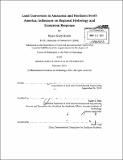Land conversion in Amazonia and Northern South America : influences on regional hydrology and ecosystem response
Author(s)
Knox, Ryan Gary
DownloadFull printable version (47.77Mb)
Other Contributors
Massachusetts Institute of Technology. Department of Civil and Environmental Engineering.
Advisor
Rafael L. Bras.
Terms of use
Metadata
Show full item recordAbstract
A numerical model of the terrestrial biosphere (Ecosystem Demography Model) is compbined with an atmospheric model (Brazilian Regional Atmospheric Modeling System) to investigate how land conversion in the Amazon and Northern South America have changed the hydrology of the region, and to see if those changes are significant enough to produce an ecological response. Two numerical realizations of the structure and composition of terrestrial vegetation are used as boundary conditions in a simulation of the regional land surface and atmosphere. One realization seeks to capture the present day vegetation condition that includes human deforestation and land-conversion, the other is an estimate of the potential structure and composition of the region without human influence. Model output is assessed for consistent and significant differences in hydrometeorology. Locations that show compelling differences are taken as case studies. The seasonal biases in precipitation at these locations are then used to create perturbations to long-term climate datasets. These perturbations then drive long-term simulations of dynamic vegetation to see if the climate consistent with a potential regional vegetation could elicit a change in the vegetation equilibrium at the site. Results show that South American land conversion has had consistent impacts on the regional patterning of precipitation. At some locations, changes in precipitation are persistent and constitute a significant fraction of total precipitation. Land-conversion has decreased mean continental evaporation and increased mean moisture convergence. Case study simulations of long term vegetation dynamic indicate that a hydrologic climate consistent with regional potential vegetation can indeed have significant influence on ecosystem structure and composition, particularly in water limited growth conditions.
Description
Thesis (Ph. D. in the Field of Hydrology)--Massachusetts Institute of Technology, Dept. of Civil and Environmental Engineering, February 2013. "February 2013." Cataloged from PDF version of thesis. Includes bibliographical references (p. 345-358).
Date issued
2013Department
Massachusetts Institute of Technology. Department of Civil and Environmental EngineeringPublisher
Massachusetts Institute of Technology
Keywords
Civil and Environmental Engineering.